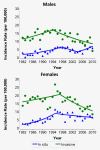Melanoma incidence trends and survival in adolescents and young adults in Queensland, Australia
- PMID: 24806428
- PMCID: PMC4277328
- DOI: 10.1002/ijc.28956
Melanoma incidence trends and survival in adolescents and young adults in Queensland, Australia
Abstract
Cutaneous melanoma is a relatively common cancer in adolescents and young adults in Australia, but detailed information about occurrence patterns and prognosis is limited. We evaluated incidence trends from 1982 to 2010 and recent survival rates in those aged 15-24 years in the state of Queensland. In situ and invasive melanoma cases were identified from the Queensland Cancer Registry. Incidence rates were age-standardised to the 2000 World population and trends calculated using joinpoint regression. Five-year relative survival was estimated by the period method and Poisson models were used to produce adjusted mortality hazard ratios. Average annual incidence rates for the 5-year period 2006-2010 were 6.3 per 100,000 [95% confidence interval (CI) 5.4, 7.2] for in situ and 10.1 per 100,000 (95% CI 9.0, 11.3) for invasive melanoma. Since the mid-1990s, incidence rates for in situ melanomas have been stabilizing while invasive melanoma has decreased in both sexes, mainly owing to declining rates of thin tumours (≤1 mm) (-5.4% per year, 95% CI -8.3%, -2.4%). Incidence rates of melanomas >1 mm in thickness have remained relatively unchanged since 1991 however. In the period 2006-2010, relative 5-year survival of 15-24 year olds with invasive melanoma was 95.7% (95% CI 92.9%, 97.5%). The subgroup with tumours >1 mm was nearly six times more likely to die within 5 years than those with thin tumours (adjusted hazard ratio = 5.53, 95% CI 1.72, 17.80). Incidence of thin melanoma in young people in Queensland is declining, suggesting benefits of primary prevention efforts are being realised.
Keywords: adolescents; incidence trends; melanoma; survival rates; young adults.
© 2014 The Authors Published by Wiley Periodicals, Inc. on behalf of UIC.
Figures



References
-
- Alston RD, Geraci M, Eden TO, et al. Changes in cancer incidence in teenagers and young adults (ages 13 to 24 years) in England 1979-2003. Cancer. 2008;113:2807–15. - PubMed
-
- .Australian Institute of Health and Welfare. Australian Cancer Incidence and Mortality (ACIM) books. Available at: http://www.aihw.gov.au/acim-books/ (Accessed 8 April 2014)
-
- Aben KK, van Gaal C, van Gils NA, et al. Cancer in adolescents and young adults (15–29 years): a population-based study in the Netherlands 1989-2009. Acta Oncol. 2012;51:922–33. - PubMed
-
- Erdmann F, Lortet-Tieulent J, Schuz J, et al. International trends in the incidence of malignant melanoma 1953–2008—are recent generations at higher or lower risk? Int J Cancer. 2013;132:385–400. - PubMed
Publication types
MeSH terms
LinkOut - more resources
Full Text Sources
Other Literature Sources
Medical

